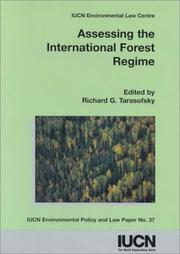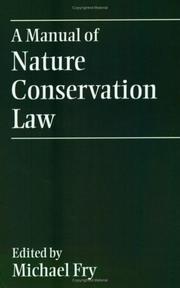| Listing 1 - 10 of 88 | << page >> |
Sort by
|
Book
ISBN: 0999126009 Year: 1991 Publisher: Gaborone Botswana Society
Abstract | Keywords | Export | Availability | Bookmark
 Loading...
Loading...Choose an application
- Reference Manager
- EndNote
- RefWorks (Direct export to RefWorks)

ISBN: 2831704723 9782831704722 Year: 1999 Volume: 37 Publisher: Gland : IUCN,
Abstract | Keywords | Export | Availability | Bookmark
 Loading...
Loading...Choose an application
- Reference Manager
- EndNote
- RefWorks (Direct export to RefWorks)
Book
ISBN: 9781138203655 9781315471211 9781315471181 1138203653 Year: 2018 Publisher: Abingdon, Oxon [UK] ; New York : Routledge,
Abstract | Keywords | Export | Availability | Bookmark
 Loading...
Loading...Choose an application
- Reference Manager
- EndNote
- RefWorks (Direct export to RefWorks)
The Natura 2000 network of protected areas is the centrepiece of European Union nature policy, currently covering almost one-fifth of the EU’s entire land territory plus large marine areas. This vast EU-wide network, which aims to conserve Europe’s most valuable and threatened species and habitats, has major impacts on land use throughout all Member States of the EU. This book critically assesses the origins and implementation of the Natura 2000 network, established under the Birds Directive of 1979 and the Habitats Directive of 1992.Based on original archival research and interviews with key participants, the book records a detailed history of the origins and negotiation of Natura 2000 policy and law, with the history of EU environmental policy provided as a framework. An historical institutionalist approach is adopted, which emphasises the importance of understanding legal and policy development as processes that unfold over time. Three phases in the history of EU environmental policy are identified and described, and the history of EU nature policy is placed within the context of these three phases. Informed by this history, the author presents a comprehensive summary and assessment of the law and policy that protects Natura 2000 sites at EU level, and reviews the nature conservation outcomes for the targeted species and habitats. The book reveals how a knowledge of the history of Natura 2000 enriches our understanding of key issues such as conflicts in establishing and conserving the Natura 2000 network, EU integration in the field of nature conservation, and the future of EU nature policy.
Wildlife conservation --- Habitat conservation --- Biodiversity conservation --- Law and legislation --- Natura 2000 (Network). --- Wildlife conservation - Law and legislation - European Union countries --- Habitat conservation - Law and legislation - European Union countries --- Biodiversity conservation - Law and legislation - European Union countries
Book
ISBN: 9781786439482 1786439484 Year: 2017 Publisher: Cheltenham, UK : Edward Elgar Publishing,
Abstract | Keywords | Export | Availability | Bookmark
 Loading...
Loading...Choose an application
- Reference Manager
- EndNote
- RefWorks (Direct export to RefWorks)
This timely book considers appropriate legal practices to use to promote conservation, protection and sustainable use of biological diversity in forest and marine areas. The breadth of issues explored across these two themes is immense, and the book identifies both key differences, and striking commonalities between them.Law-makers, managers and users often have little understanding of either the complexity or the true value of biological diversity and of what is needed to preserve forest and marine ecosystems, and to keep inter-relationships between species within them healthy. Regulators face significant and practical challenges, requiring the adoption of legal frameworks in the context of scientific uncertainty. This book provides critical and comparative reflections on the role of law in both of these biodiversity contexts. Key issues not previously addressed through the law are considered - for example, the lack of international governance of peat; and the moral problem of labelling certain species as 'alien' or 'invasive'. Learned contributors draw valuable lessons for those seeking to protect biodiversity and understand its governance, from analysis of experiences gained forging international and national legal frameworks.With a blend of local and global perspectives, across a wide range of countries and policies, the book will appeal to academics and students in law, international, regional and domestic policymakers, lawmakers, NGOs and conservation agencies

ISBN: 0198259581 9780198259589 Year: 1995 Publisher: Oxford New York Clarendon Press Oxford University Press
Abstract | Keywords | Export | Availability | Bookmark
 Loading...
Loading...Choose an application
- Reference Manager
- EndNote
- RefWorks (Direct export to RefWorks)

ISBN: 0414013557 9780414013551 Year: 2002 Publisher: Edinburgh : Green,
Abstract | Keywords | Export | Availability | Bookmark
 Loading...
Loading...Choose an application
- Reference Manager
- EndNote
- RefWorks (Direct export to RefWorks)
Book
ISBN: 9781610919135 1610919130 1642830984 1610919157 Year: 2019 Publisher: Island Press
Abstract | Keywords | Export | Availability | Bookmark
 Loading...
Loading...Choose an application
- Reference Manager
- EndNote
- RefWorks (Direct export to RefWorks)
Book
ISBN: 1783474246 9781783474240 1783474254 Year: 2017 Publisher: Cheltenham, UK : Edward Elgar Publishing,
Abstract | Keywords | Export | Availability | Bookmark
 Loading...
Loading...Choose an application
- Reference Manager
- EndNote
- RefWorks (Direct export to RefWorks)
The Elgar Encyclopedia of Environmental Law is a landmark reference work, providing definitive and comprehensive coverage of this dynamic field. Each volume probes the key elements of law, the essential concepts, and the latest research through concise, structured entries written by international experts. Each entry includes an extensive bibliography as a starting point for further reading. The mix of authoritative commentary and insightful discussion will make this an essential tool for research and teaching, as well as a valuable resource for professionals and policymakers.The unprecedented degradation of the planet’s vital ecosystems and species, and the consequent damage to the variability of life on Earth, are one of the most pressing issues confronting the international community. The purpose of this volume of the Elgar Encyclopedia of Environmental Law is to provide a critical assessment of international biodiversity law in the face of the failed attempts to reduce the global trend in irreversible biodiversity loss and the need to increase efforts, including through indirect drivers of change such as institutions, governance and legal frameworks. The volume assesses comprehensively how and to what extent international law has addressed the key concerns presently facing biodiversity conservation, made recourse to conventional and market-based approaches to biodiversity conservation and sustainable use, tackled cross-cutting issues, and considered direct as well as indirect changes in socio-economic conditions. In doing so, the volume examines the historical development, principles, themes and cross cutting issues of international biodiversity law. Each article, written by an invited expert in that field, contains an overview of the topic, provides a concise review of current knowledge, identifies new directions for cutting-edge research and offers an extensive bibliography.This major research-focused resource and its in-depth exploration of the field of biodiversity law is an essential reference for university students, teachers, researchers, practitioners and policy makers.
Book
ISBN: 9780415659055 041565906X 9780415659062 9780203075333 9781135119614 9781135119652 0415659051 Year: 2014 Publisher: Abingdon Routledge
Abstract | Keywords | Export | Availability | Bookmark
 Loading...
Loading...Choose an application
- Reference Manager
- EndNote
- RefWorks (Direct export to RefWorks)
Wildlife conservation (International law). --- Whales --- Elephants --- Conservation --- Law and legislation. --- Wildlife conservation (International law) --- Law and legislation --- Elephantidae --- Pachyderms --- Proboscidea (Mammals) --- Cetacea --- International law --- Conservation&delete& --- Whales - Conservation - Law and legislation --- Elephants - Conservation - Law and legislation
Book
ISBN: 9781138298620 113829862X 9781315098517 9781351580328 Year: 2018 Publisher: Abingdon Routledge
Abstract | Keywords | Export | Availability | Bookmark
 Loading...
Loading...Choose an application
- Reference Manager
- EndNote
- RefWorks (Direct export to RefWorks)
Debates about Access and Benefit Sharing (ABS) have moved on in recent years. An initial focus on the legal obligations established by international agreements like the United Nations Convention on Biological Diversity and the form of obligations for collecting physical biological materials have now moved to a far more complex series of disputes and challenges about the ways ABS should be implemented and enforced: repatriation of resources, technology transfer, traditional knowledge and cultural expressions; open access to information and knowledge, naming conventions, farmers’ rights, new schemes for accessing pandemic viruses and sharing DNA sequences, and so on. Unfortunately, most of this debate is now crystallised into apparently intractable discussions such as implementing the certificates of origin, recognising traditional knowledge and traditional cultural expression as a form of intellectual property, and sovereignty for Indigenous peoples. Not everything in this new marketplace of ABS has been created de novo. Like most new entrants, ABS has disrupted existing legal and governance arrangements. This collection of chapters examines what is new, what has been changed, and what might be changed in response to the growing acceptance and prevalence of ABS of genetic resources.Biodiversity, Genetic Resources and Intellectual Property: Developments in Access and Benefit Sharing of Genetic Resources addresses current issues arising from recent developments in the enduring and topical debates about managing genetic resources through the ABS regime. The book explores key historical, doctrinal, and theoretical issues in the field, at the same time developing new ideas and perspectives around ABS. It shows the latest state of knowledge and will be of interest to researchers, academics, policymakers, and students in the fields of intellectual property, governance, biodiversity and conservation, sustainable development, and agriculture
Biodiversity conservation --- Germplasm resources conservation --- Intellectual property --- Law and legislation --- IP (Intellectual property) --- Proprietary rights --- Rights, Proprietary --- Intangible property --- Environmental law --- Biodiversity conservation - Law and legislation --- Germplasm resources conservation - Law and legislation
| Listing 1 - 10 of 88 | << page >> |
Sort by
|

 Search
Search Feedback
Feedback About UniCat
About UniCat  Help
Help News
News